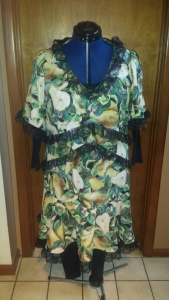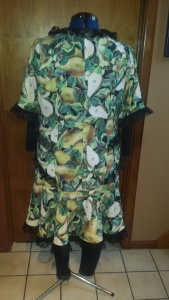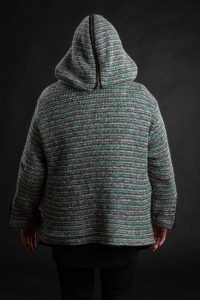Boundless Style is a pattern book and companion website with coordinating bodices, sleeves and skirts. All the pieces can be mixed and matched, and if that doesn’t give you enough combinations, suggestions for design variations are included. The author is Kristianna Boos, designer of Victory Patterns. The pattern pieces are on an enclosed dvd.
Boundless Style offers five bodices, skirts, and sleeves. The bodices are all fitted and stop at waist length, so they can be joined to any of the skirts. All the sleeve styles are set in sleeves. These are not your usual basics. They are strong, unique design styles.
Table of Contents
Introduction
Chapter 1: Getting Started
Chapter 2: Tools
Chapter 3: Skills and Techniques
Chapter 4: Bodices
Chapter 5; Sleeves
Chapter 6: Skirts
Chapter 7: Putting it All Together
Index
About the Author
The Introduction is a brief three paragraphs. It does exactly what an introduction is supposed to do, and does it elegantly. It explains the inspiration, describes the concept, and introduces the contents.
Getting Started explains how to use the online lookbook to create unique looks, how to join the design group, how to see other people’s public designs, and how to keep your own public or private.
Unfortunately the URL provided in the text (https://lookbook.victorypatterns.com) does not exist. The URL https://victorypatterns.com/blogs/victory-patterns-blog/welcome-to-lookbook-for-boundless-style takes you to an article about Boundless Style on the Victory Patterns website. But, it does not have any active links, and I was unable to find anything else about the lookbook.
The book itself goes on to cover printing, assembling and tracing patterns. It discusses fabrics, notions and supplies. It includes diagrams for laying out pattern pieces on fabric and how to find the sizes on the pattern pieces. Then it goes on to discuss fitting, from measuring and sizing charts to grading between sizes, lengthening and shortening and fitting as you sew.
Tools divides sewing tools into six categories: pins and needles, marking tools, measuring tools, cutting tools, pressing tools and notions and supplies. It’s an extensive list!
Skills and Techniques is divided into Marking, Hand Stitching Techniques, Machine Stitching Techniques, and Finishing Touches. I’m not sure I love this particular way of dividing things, because Hand Stitching is a single page demonstrating how to make 4 different hand stitches. Machine Stitching Techniques is 9 pages long and covers directional sewing, gathering by machine, ease stitching by machine, inserting a sleeve, eliminating bulk, sewing darts, stabilizing seams, understitching, top stitching and ditch stitching. Finishing Touches is 7 pages long and covers making bias tape, piping seams, installing centered zippers and installing invisible zippers.
The Bodices chapter dives into the patterns. It includes five bodices; Catrina, Jackie, Celine, Georgia, and Billie. Each of these bodices has a strong design statement. Catrina has princess seams originating high on the armhole. Jackie has a deep V that can be in front or in back. The opposite side has a jewel neckline and optional contrasting wrap at the waist. Celine has unique central darts and an optional tie neck. Georgia is a wrap style top with yoke and gathers. Billie has a jewel neck with a stand up collar and shaping seams running from low on the armhole to a center point at the waist.
The instructions for each pattern starts off with the technical drawing (s) for all versions. A Skills box lists the sewing skills needed to complete that pattern, and instructions on how to choose your size. Photos of sewn examples of the pattern pepper the chapters, and each photo includes Design Notes that describe the elements used (bodice, etc) and the fabrics used. Inventory sheets list the pattern pieces used, tools, fabric, and supplies required, and suggested fabrics. They’re followed by step by step instructions, each one illustrated with a clear color photograph.
Only the instructions for Jackie explain how to insert sleeves or finish the armholes for a sleeveless bodice. The instructions for the other blouses do not touch on sleeves or finishing armholes, although the photographs show sleeved garments.
Sleeves covers five sleeves: Moss (cap), Grace (fitten) Farah (long, full) Monroe (two piece box pleat, 3/4) and Berdot (somewhat loose, short, 3/4 or long). It begins by explaining a set in sleeve pattern piece. Like the Bodices chapter, each sleeve has a technical drawing (s) for all versions, Skills box lists the sewing skills needed to complete that pattern, and instructions on how to choose your size. Photos of sewn examples and Design Notes offer suggestions for bodice and skirt combinations to go with the sleeve. Inventory sheets list the pattern pieces used, tools, fabric, and supplies required, and suggested fabrics. They’re followed by step by step instructions, each one illustrated with a clear color photograph. The final section explains how to finish a sleeveless bodice.
Moss shows one version, because there isn’t much you can do with a simple cap sleeve, although they do suggest using a contrasting fabric for the sleeve. Grace is shown in three different lengths, short, three quarter, and long. Farah also has one version, gathered at the wrist with a narrow band. Monroe clever, unique sleeve. Instead of ease or gathers, all the upper arm fullness is in a single box pleat. The fullness is pinched back in at the elbow, giving the sleeve and ever so slightly hint of leg-o-mutton. The coolest feature is the inside of the pleat can be a different color. Bardot is a loose but not full sleeve. Instead of gathers, the fullness is distributed into two tucks meeting at the shoulder seam.
Skirts includes five silhouettes, Frieda (dirndl) Ella (a-line) Sophia (pencil with kick pleat) Meryl (full) and Lydia (pleated). The skirt lengths are peplum (very short, blouse length, not a dress), cocktail (just above the knee), Lydia Tea (just below the knee), Ella and Sophia Tea (a few inches below the knee) and mid-calf. Just like the chapters on Bodices and Sleeves, each style includes technical drawings, etc.
Frida is shown in peplum, cocktail and Tea (unspecified) length, plus tea length with a contrasting border. Ella is cut on the bias, and shown in peplum, cocktail, and Ella Tea lengths, plus a tea length with a flounce (not a ruffle) hem. Sophia is shown in cocktail and Sophia Tea lengths, and instructions to use a centered rear zipper when making the skirt only (no bodice). Meryl is shown in peplum, cocktail and mid-calf versions. Lydia is shown in peplum, cocktail, and Lydia Tea lengths.
The chapter finishes with a discussion of skirt linings in general, and specific instructions for each version, illustrated with photographs.
Putting it all Together is divided into two sections. The first, Dress and Blouse Map is a construction guide for making a blouse or dress, the second, Separate Skirt Map is a construction guide for making a skirt. The Dress and Blouse Map starts with an illustrated guide to the general construction steps, then covers setting in a sleeve, attaching the skirt to the bodice for lined and unlined dresses and blouses, inserting a side zipper for lined or unlined dress or blouse, inserting a skirt lining into a dress, inserting a waistline stay, balancing the hem, straight hem by machine, straight hem by hand and a curved hem. Like all the other techniques, each one is broken down step by step and illustrated with photographs. Separate Skirt Map starts with and illustration of the basic construction steps and covers installing a zipper, attaching a lining, and attaching the skirt waistband. Zipper insertion is the only technique that is not covered in detail, because that was done elsewhere in the book.
CONCLUSION
There’s only so much you can do with a skirt. But the patterns for bodices (and to some degree the sleeves also) are strong, unique original designs you are unlikely to find anywhere else. When I visited the Victory Patterns website, none of the patterns in this book appeared anywhere.
I like the bodice styles and the pleated sleeves are really interesting.
I have not actually used any of these pattern pieces yet, and I’ve never used a Victory Pattern, so I can’t comment on sizing or drafting. I can say that these instructions are very clear. And I like the inclusion of a waist stay on the dress patterns.
 This cute dress has princess seams, a v-shaped raglan neckline, and an upside down v-shaped insert at the waist.
This cute dress has princess seams, a v-shaped raglan neckline, and an upside down v-shaped insert at the waist. I basted the lace along the bias edges, then sewed the seams with the machine. After a quick test fit, I tweaked a few vertical seams. Then, I finished all the seams with the serger. I based lace along the bottom of the sleeve and the hem. Then I resewed them with the serger. I turned the serged edge under, and topstitched. I finished the neckline last. I basted the lace to the edge, applied the facing, turned the facing under and topstitched.
I basted the lace along the bias edges, then sewed the seams with the machine. After a quick test fit, I tweaked a few vertical seams. Then, I finished all the seams with the serger. I based lace along the bottom of the sleeve and the hem. Then I resewed them with the serger. I turned the serged edge under, and topstitched. I finished the neckline last. I basted the lace to the edge, applied the facing, turned the facing under and topstitched.






